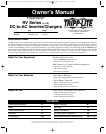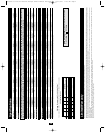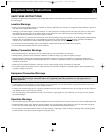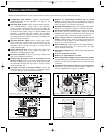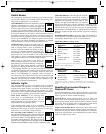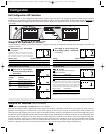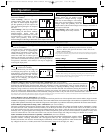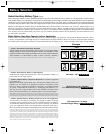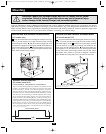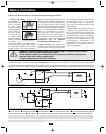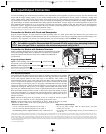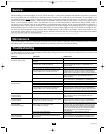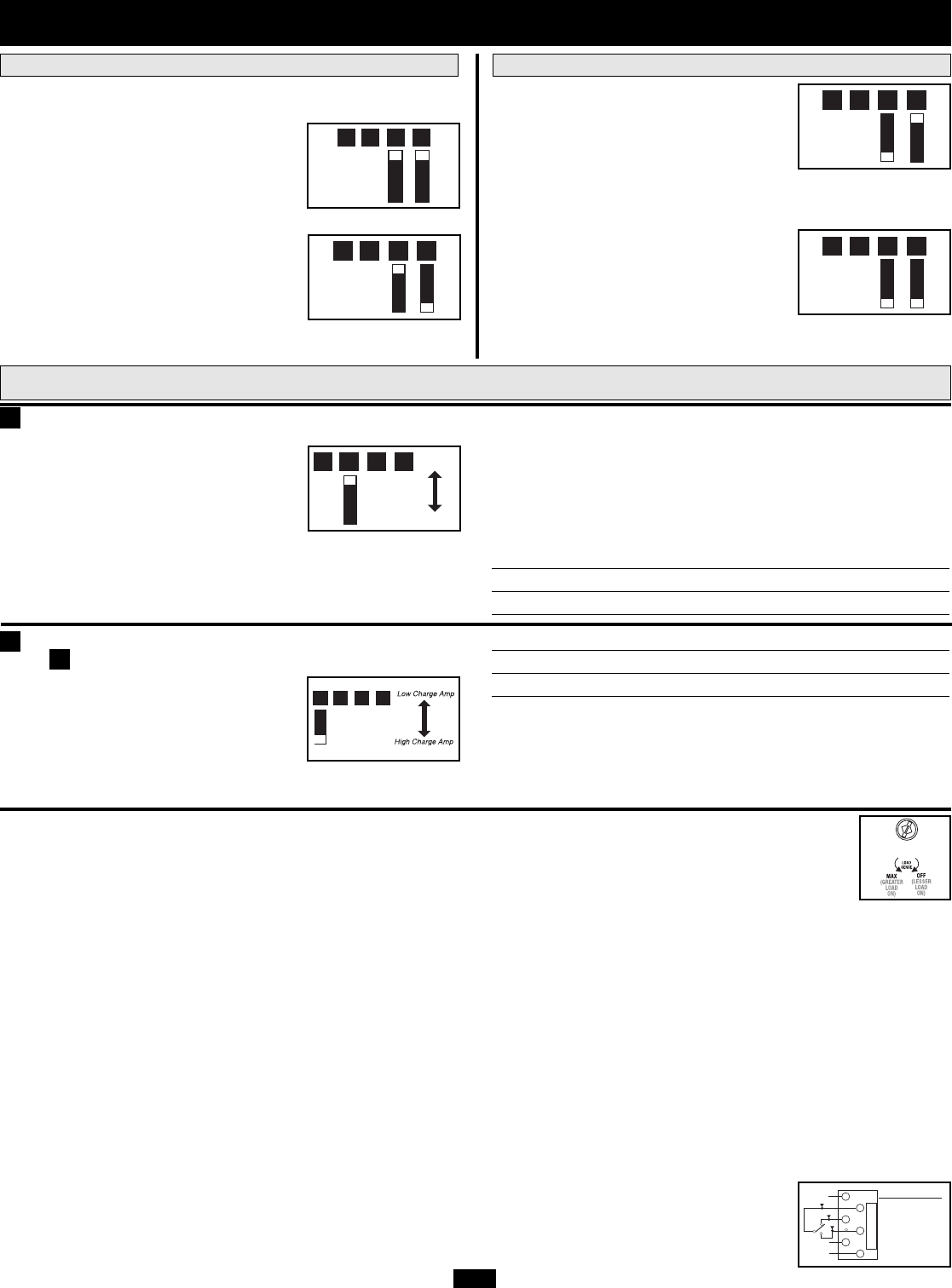
7R
Set Battery Charging Amps—OPTIONAL (function included
on switch on 612 models)
Check specifications for your unit’s high- and
low-charging amp options. By setting on
high charging, your batteries will charge at
maximum speed and your RV 12V DC
system loads will be well-supplied. When
setting on low charging, you lengthen the life of your batteries
(especially smaller ones).
Battery Charger Switch Position
Low Charge Amps Up
High Charge Amps Down (factory setting)
CAUTION: When switching to the High Charge Amp setting, the user must ensure that the
amp hour capacity of their battery system exceeds the amperage of the High Charge Amp
setting or the batteries may be damaged or degraded.
Select Equalize Battery Charge—OPTIONAL
(Not on 612 Models)
This DIP Switch is momentarily engaged
to begin the process of equalizing the
charge state of your battery’s cells by time-
limited overcharge of all cells. This can
extend the useful life of certain types of
batteries; consult with your battery’s manufacturer to determine if
your batteries could benefit from this process. The charge equaliza-
tion process is automatic; once started, it can only be stopped by
removing the input power.
Setting Procedure
• Move to “Equalize” (DOWN) position for three seconds.
• Move to “Reset” (UP) position and leave it there. This is the
factory default setting.
CAUTION: Do not leave DIP switch #B3 in the down position after beginning process. Battery
charge equalization should only be performed in strict accordance with the battery manufacturer’s
instructions and specifications.
Battery Charge Switch Position
Reset Up (factory setting)
Equalize Down—momentarily
Select Battery Charger-Limiting Points—OPTIONAL
(Not on 612 Models)
“Most Limiting” (#B2 & #B1 Up):
Charger-limiting takes effect the moment
any 120V AC load is applied; charger out-
put falls gradually from full output at no
120V load passing through to no output at
full load.
“Less Limiting” (#B2 Up & #B1 Down,
factory setting for RV1012UL models):
Charger-limiting begins when the
Inverter/Charger’s load reaches 33% of the
Inverter/Charger’s load rating. Charger
output falls gradually from full output at 33% of the
Inverter/Charger’s load rating to about 40% of full output at full load.
“Least Limiting” (#B2 Down & #B1 Up,
factory setting for all models except
RV1012UL): Charger-limiting begins
when the Inverter/Charger’s load reaches
66% of the Inverter/Charger’s load rating.
Charger output falls gradually from full
output at 66% of the Inverter/Charger’s load rating to about 40% of
full output at full load.
“No Limiting” (#B2 & #B1 Down): No
charger-limiting occurs at any load size.
Configuration
(continued)
B1B2B3B4
B1B2B3B4
B1B2B3B4
B1B2B3B4
B1B2B3B4
Set Battery Charge Conserver (Load Sense) Dial—OPTIONAL (Not on 612 models)
In order to save battery power, the unit’s inverter automatically shuts off in the absence of any power demand from connected
equipment or appliances (the electrical load). When the unit detects a load, it automatically turns its inverter function on.
Users may choose the minimum load the Inverter/Charger will detect by adjusting the Battery Charge Conserver Dial (see
diagram). Using a small tool, turn the dial clockwise to lower the minimum load that will be detected, causing the inverter to
turn on for smaller loads. When the dial is turned fully clockwise, the inverter will operate even when there is no load. Turn the dial counter-
clockwise to increase the minimum load that will be detected, causing the inverter to stay off until the new minimum load is reached.
Note: the factory setting for the dial is fully clockwise. However, based on the threshold load to which you’d like the inverter to respond, you should adjust the dial counterclockwise to reduce its sensi-
tivity until the inverter is active only when connected equipment or appliances are actually in use.
Connect Remote Control—OPTIONAL (All models)
All models feature an 8-conductor telephone style receptacle on the front panel for use with an optional remote control module (Tripp Lite model
APSRM2, sold separately or included with select models). The remote module allows the Inverter/Charger to be mounted in a compartment or cabinet out
of sight, while operated conveniently from within the living area or control panel of your RV. See instructions packed with the remote control module.
Connect Battery Temperature Sensing Cable—OPTIONAL (not on 612 models)
The battery temperature sensing function prolongs battery life by adjusting the charge float voltage level based on battery temperature. Connect
the sensor cable (the cable, included with select models, has an RJ style connector on one end and a black sensor on the other) to the RJ
style jack located on the side of the Inverter/Charger labeled “Remote Temp. Sense.” Affix the sensor to the side of your battery below the
electrolyte level. To guard against false readings due to ambient temperature, place the sensor between batteries, if possible, or away from
sources of extreme heat or cold. If the sensor cable is not used, the Inverter/Charger will charge according to its default 25º C values.
Utilize Automatic Generator Starter Capability—OPTIONAL (not on 612 models)
All models except 612 models include an RJ type modular jack on the side panel labeled “Generator Start”. Attach to vehicle
generator ON/OFF switching mechanism with user-supplied cable (see Pin Configuration Diagram). Once
attached, the interface will allow the Inverter/Charger to automatically switch a vehicle generator on when connected bat-
tery voltage levels are low (11.6 VDC) and switch it off when battery voltage levels are high (14.1 VDC).
Reset
Equaliz
e
B1B2B3B4
B4
B3
A4
1
2
3
4
5
6
Pin Configuration
2 - Common
3 - N.C.
(Normally Closed)
4 - N.O.
(Normally Open)
All Models, except RV612UL & RV612ULH* All Models, except RV612UL, RV612ULH & RV1012UL*
* NOTE! RV612UL & RV612ULH models do not include these DIP Switches. There are only two limiting points available for RV1012UL models—"Most Limiting" and "Less Limiting"—which
are determined solely by the position of the B1 DIP Switch (either up or down). The B2 DIP Switch on these models has no affect.
200310080 93-2182 RV Inverter-Charger Owner’s Manual Revision.qxd 10/17/2003 11:43 AM Page 7



